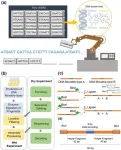(Press-News.org) Tumor vaccines can help the body fight cancer. These vaccines alert the patient's immune system to proteins that are carrying cancer-typical alterations. Physicians and cancer researchers from Heidelberg and Mannheim have now treated adult patients with advanced midline gliomas, difficult-to-treat brain tumors, with a peptide vaccine for the first time. The vaccine mimicked a mutational change in a histone protein typical of this type of cancer. The vaccine proved to be safe and induced the desired immune responses directed against the brain tumor.
Crucial for the success of cancer vaccinations are protein structures by which the immune cells can recognize the cancer - and which are not present (or only to a small extent) on healthy cells. Mutations in the tumor genome often lead to protein structures that are altered in a way typical of cancer.
Diffuse midline gliomas are among the most aggressive brain tumors. They usually occur in children and young adults near the brain stem and are therefore difficult to access surgically. Chemotherapy or radiation therapy also have limited effectiveness. In this type of cancer, mutations characteristically occur in the gene encoding histone H3 (H3K27M), a packaging protein of DNA. The mutation gives rise to a novel protein structure - a so-called neoepitope - that can be recognized as foreign by the patient's immune system.
"Such mutations, which occur in identical form in many patients, are rare in cancer. They literally lend themselves to the development of tumor vaccines because they occur in all cancer cells, since the mutated histone is causative for the development of midline gliomas. This means that vaccination against the mutated protein gets to the root of the problem," explains Michael Platten, Director of the Department of Neurology at the University Medical Center Mannheim and Head of Department at the German Cancer Research Center (DKFZ).
The researchers led by Katharina Sahm and Michael Platten synthetically reconstructed the section of the histone H3 protein with the characteristic mutation. Using this peptide, they were able to curb the growth of H3K27M-mutated tumors in a mouse model*. Encouraged by the results, the team decided to test the mutation-specific vaccine produced at the University of Tübingen in patients in a phase I-trial**, which is still ongoing.
In parallel, the physicians, together with colleagues from Munich, Berlin, Bonn and Münster, treated eight adult patients with the peptide vaccine in time-limited individual curative trials. These patients, who could not be enrolled in the trial protocol, suffered from diffuse midline gliomas with H3K27M mutation that progressed after standard therapy. Some of the affected individuals received therapy with immune checkpoint inhibitors in addition to tumor vaccination.
No serious side effects were observed in any of the vaccinated patients. Five of the eight treated patients developed specific immune responses against the mutant protein, which were dominated by CD4 T-helper cells. In one of the patients who had shown a strong immune response, the tumor regressed completely and she remained tumor-free for 31 months.
The vaccine peptide, which is comparatively long at 27 amino acids, worked in patients with different HLA variants. HLA proteins are responsible for the presentation of the mutant peptide on the cell surface and differ from person to person depending on their genetic background. Supported by the HI-TRON Mainz - Helmholtz Institute of the DKFZ, the researchers also observed that immune responses decreased over time, so repeated administration of the vaccine could support a sustained effect.
"We cannot make any further statements about the efficacy of the vaccination based on these treatments. In any case, the current study has given us valuable information that will help us to further optimize the development of brain tumor vaccines in the future," explains the study's senior author Katharina Sahm, senior physician at the Neurological University Hospital Mannheim and DKFZ researcher. A phase I-trial is currently underway to test the vaccine against the H3K27M mutation in patients with newly diagnosed midline gliomas. Evaluation is expected to begin around 2025.
The project was funded by the Translational Oncology funding program of German Cancer Aid (Deutsche Krebshilfe).
Publication:
Niklas Grassl, Isabel Poschke, Katharina Lindner, Lukas Bunse, Iris Mildenberger, Tamara Boschert, Kristine Jähne, Edward W. Green, Ingrid Hülsmeyer, Simone Jünger, Tobias Kessler, Abigail K. Suwala, Philipp Eisele, Michael O. Breckwoldt, Peter Vajkoczy, Oliver M. Grauer, Ulrich Herrlinger, Joerg-Christian Tonn, Monika Denk, Felix Sahm, Martin Bendszus, Andreas von Deimling, Frank Winkler, Wolfgang Wick, Michael Platten & Katharina Sahm: A H3K27M-targeted vaccine in adults with diffuse midline glioma
Nature Medicine 2023, https://doi.org/10.1038/s41591-023-02555-6
* Katharina Ochs et al.: K27M-mutant histone-3 as a novel target for glioma immunotherapy. Oncoimmunology 2017, DOI: 10.1080/2162402X.2017.1328340
** INTERCEPT-H3 trial: https://classic.clinicaltrials.gov/ct2/show/NCT04808245
With more than 3,000 employees, the German Cancer Research Center (Deutsches Krebsforschungszentrum, DKFZ) is Germany’s largest biomedical research institute. DKFZ scientists identify cancer risk factors, investigate how cancer progresses and develop new cancer prevention strategies. They are also developing new methods to diagnose tumors more precisely and treat cancer patients more successfully. The DKFZ's Cancer Information Service (KID) provides patients, interested citizens and experts with individual answers to questions relating to cancer.
To transfer promising approaches from cancer research to the clinic and thus improve the prognosis of cancer patients, the DKFZ cooperates with excellent research institutions and university hospitals throughout Germany:
National Center for Tumor Diseases (NCT, 6 sites)
German Cancer Consortium (DKTK, 8 sites)
Hopp Children's Cancer Center (KiTZ) Heidelberg
Helmholtz Institute for Translational Oncology (HI-TRON Mainz) - A Helmholtz Institute of the DKFZ
DKFZ-Hector Cancer Institute at the University Medical Center Mannheim
National Cancer Prevention Center (jointly with German Cancer Aid)
The DKFZ is 90 percent financed by the Federal Ministry of Education and Research and 10 percent by the state of Baden-Württemberg. The DKFZ is a member of the Helmholtz Association of German Research Centers.
END
Mutation-specific peptide vaccine against midline gliomas used in patients for the first time
2023-09-21
ELSE PRESS RELEASES FROM THIS DATE:
This parasitic plant convinces hosts to grow into its own flesh—it’s also an extreme example of genome shrinkage
2023-09-21
If you happen to come across plants of the Balanophoraceae family in a corner of a forest, you might easily mistake them for fungi growing around tree roots. Their mushroom-like structures are actually inflorescences, composed of minute flowers.
But unlike some other parasitic plants that extend an haustorium into host tissue to steal nutrients, Balanophora induces the vascular system of their host plant to grow into a tuber, forming a unique underground organ with mixed host-parasite tissue. This ...
Mutations in 11 genes associated with aggressive prostate cancer identified in new research
2023-09-21
An international research team led by scientists in the Center for Genetic Epidemiology at the Keck School of Medicine of USC and USC Norris Comprehensive Cancer Center has singled out mutations in 11 genes that are associated with aggressive forms of prostate cancer. These findings come from the largest-scale prostate cancer study ever exploring the exome — that is, the key sections of the genetic code that contain the instructions to make proteins. The scientists analyzed samples from about 17,500 prostate cancer ...
Dinosaur feathers reveal traces of ancient proteins
2023-09-21
Palaeontologists at University College Cork (UCC) in Ireland have discovered X-ray evidence of proteins in fossil feathers that sheds new light on feather evolution.
Previous studies suggested that ancient feathers had a different composition to the feathers of birds today. The new research, however, reveals that the protein composition of modern-day feathers was also present in the feathers of dinosaurs and early birds, confirming that the chemistry of feathers originated much earlier than previously thought.
The research, published today in Nature Ecology and Evolution, was led by palaeontologists ...
Researchers develop first method to study microRNA activity in single cells
2023-09-21
MicroRNAs are small molecules that regulate gene activity by binding to and destroying RNAs produced by the genes. More than 60% of all human genes are estimated to be regulated by microRNAs, therefore it is not surprising that these small molecules are involved in many biological processes including diseases such as cancer. To discover the function of a microRNA, it is necessary to find out exactly which RNAs are targeted by it. While such methods exist, they require a lot of material typically in order of millions of cells, to ...
Nanoparticles made from plant viruses could be farmers’ new ally in pest control
2023-09-21
A new form of agricultural pest control could one day take root—one that treats crop infestations deep under the ground in a targeted manner with less pesticide.
Engineers at the University of California San Diego have developed nanoparticles, fashioned from plant viruses, that can deliver pesticide molecules to soil depths that were previously unreachable. This advance could potentially help farmers effectively combat parasitic nematodes that plague the root zones of crops, all while minimizing costs, pesticide use and environmental toxicity.
Controlling infestations caused by root-damaging nematodes has long been a challenge in agriculture. One reason is that the types of pesticides ...
Social vs. language role: researchers question function of two brain areas
2023-09-21
A research team led by Prof. LIN Nan from the Institute of Psychology of the Chinese Academy of Sciences found that during sentence processing, the neural activity of two canonical language areas, i.e., the left ventral temporoparietal junction (vTPJ) and the lateral anterior temporal lobe (lATL), is associated with social-semantic working memory rather than language processing per se.
The study was published in Nature Human Behaviour on Sept. 21.
Language and social cognition are two deeply interrelated abilities of the human species, but have traditionally been studied ...
Inauguration ceremony of carbon future
2023-09-21
On September 17th, 2023, Carbon Future, an international interdisciplinary journal sponsored by Tsinghua University, has been officially inaugurated.
Carbon Future is an open access, peer-reviewed and international interdisciplinary journal that reports carbon-related materials and processes, including carbon materials, catalysis, energy conversion and storage, as well as low carbon emission process and engineering. The journal is published quarterly by Tsinghua University Press, and publicly released on SciOpen, an internationally digital ...
Revolutionizing data storage: DNA movable-type system paves the way for sustainable data storage technology
2023-09-21
In a groundbreaking study published in Engineering, researchers have developed a revolutionary method for data storage using DNA. The paper titled “Engineering DNA Materials for Sustainable Data Storage Using a DNA Movable-Type System” introduces a novel approach that utilizes DNA fragments, referred to as “DNA movable types,” for data writing, thereby eliminating the need for costly and environmentally hazardous DNA synthesis.
DNA molecules have long been recognized as green materials ...
NIH center grant bolsters male contraceptive research
2023-09-21
Weill Cornell Medicine has received a three-year, nearly $6 million grant to lead one of three national contraceptive research centers. The grant from the Eunice Kennedy Shriver National Institute of Child Health and Human Development, part of the National Institutes of Health, will fund the Weill Cornell Medicine Contraception Development Research Center. Led by Drs. Jochen Buck and Lonny Levin, both professors of pharmacology at Weill Cornell Medicine, the center will focus on developing an on-demand male contraceptive.
“It’s an honor to be selected for a second time for this award,” Dr. Levin ...
Supportive later-life social relationships mediate the risk of severe frailty in adults who had negative childhood experiences
2023-09-21
INDIANAPOLIS -- Frailty is a serious concern in later-life adults due to its association with additional health risks including disability, falls, hospitalization and mortality. The prevalence of frailty has risen over time; about 15 percent of those aged 65 years and older are considered frail.
In one of the first studies to analyze the mediating effects of social relationships in the relationship between childhood experiences and frailty, Regenstrief Research Scientist Monica M. Williams-Farrelly, PhD, has found ...



